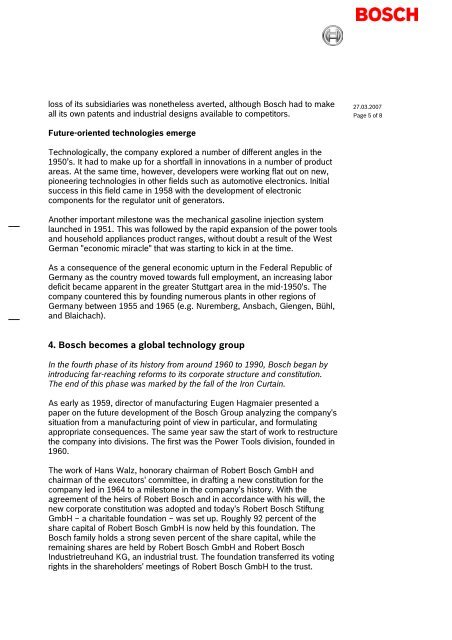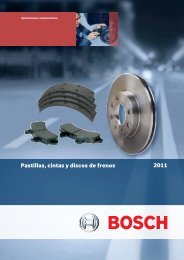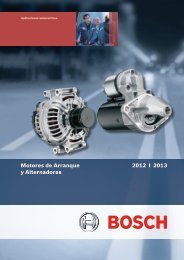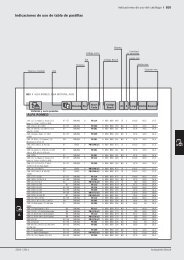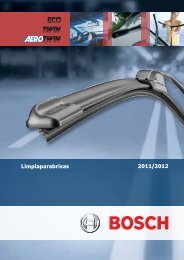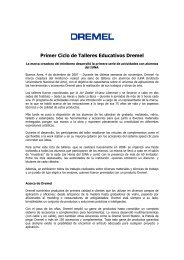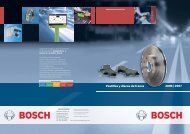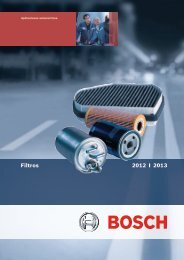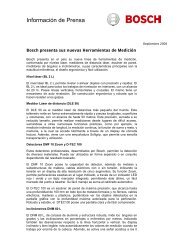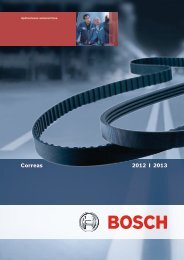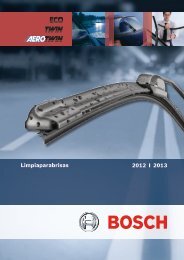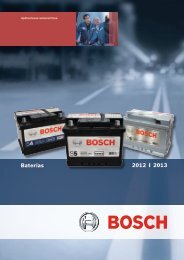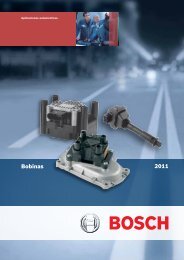Bosch Company History - Bosch Argentina
Bosch Company History - Bosch Argentina
Bosch Company History - Bosch Argentina
You also want an ePaper? Increase the reach of your titles
YUMPU automatically turns print PDFs into web optimized ePapers that Google loves.
loss of its subsidiaries was nonetheless averted, although <strong>Bosch</strong> had to make<br />
all its own patents and industrial designs available to competitors.<br />
27.03.2007<br />
Page 5 of 8<br />
Future-oriented technologies emerge<br />
Technologically, the company explored a number of different angles in the<br />
1950’s. It had to make up for a shortfall in innovations in a number of product<br />
areas. At the same time, however, developers were working flat out on new,<br />
pioneering technologies in other fields such as automotive electronics. Initial<br />
success in this field came in 1958 with the development of electronic<br />
components for the regulator unit of generators.<br />
Another important milestone was the mechanical gasoline injection system<br />
launched in 1951. This was followed by the rapid expansion of the power tools<br />
and household appliances product ranges, without doubt a result of the West<br />
German "economic miracle" that was starting to kick in at the time.<br />
As a consequence of the general economic upturn in the Federal Republic of<br />
Germany as the country moved towards full employment, an increasing labor<br />
deficit became apparent in the greater Stuttgart area in the mid-1950's. The<br />
company countered this by founding numerous plants in other regions of<br />
Germany between 1955 and 1965 (e.g. Nuremberg, Ansbach, Giengen, Bühl,<br />
and Blaichach).<br />
4. <strong>Bosch</strong> becomes a global technology group<br />
In the fourth phase of its history from around 1960 to 1990, <strong>Bosch</strong> began by<br />
introducing far-reaching reforms to its corporate structure and constitution.<br />
The end of this phase was marked by the fall of the Iron Curtain.<br />
As early as 1959, director of manufacturing Eugen Hagmaier presented a<br />
paper on the future development of the <strong>Bosch</strong> Group analyzing the company's<br />
situation from a manufacturing point of view in particular, and formulating<br />
appropriate consequences. The same year saw the start of work to restructure<br />
the company into divisions. The first was the Power Tools division, founded in<br />
1960.<br />
The work of Hans Walz, honorary chairman of Robert <strong>Bosch</strong> GmbH and<br />
chairman of the executors' committee, in drafting a new constitution for the<br />
company led in 1964 to a milestone in the company’s history. With the<br />
agreement of the heirs of Robert <strong>Bosch</strong> and in accordance with his will, the<br />
new corporate constitution was adopted and today's Robert <strong>Bosch</strong> Stiftung<br />
GmbH − a charitable foundation − was set up. Roughly 92 percent of the<br />
share capital of Robert <strong>Bosch</strong> GmbH is now held by this foundation. The<br />
<strong>Bosch</strong> family holds a strong seven percent of the share capital, while the<br />
remaining shares are held by Robert <strong>Bosch</strong> GmbH and Robert <strong>Bosch</strong><br />
Industrietreuhand KG, an industrial trust. The foundation transferred its voting<br />
rights in the shareholders' meetings of Robert <strong>Bosch</strong> GmbH to the trust.


